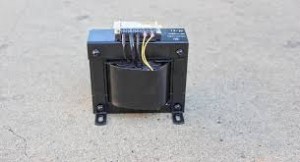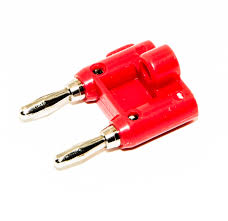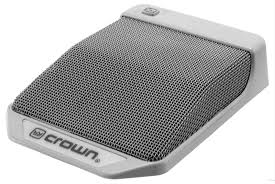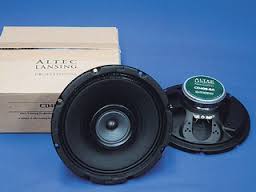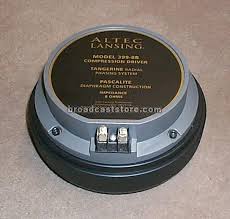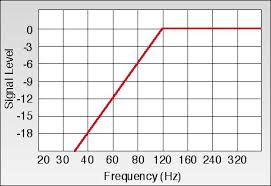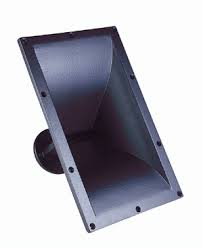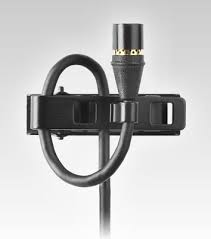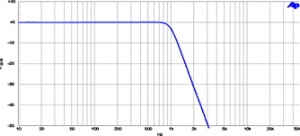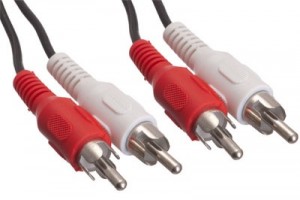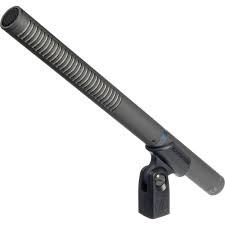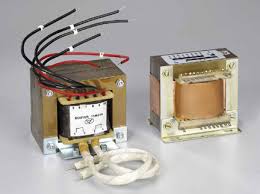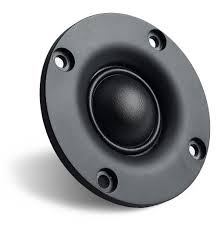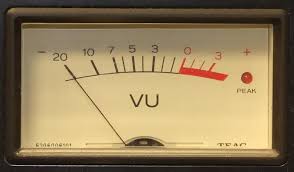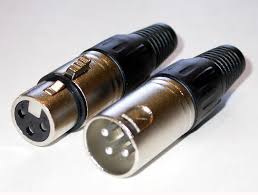Glossary of Terms
*Definitions in bold include pictures.
⅓-Octave Graphic Equalizer
¼ Phone Connector
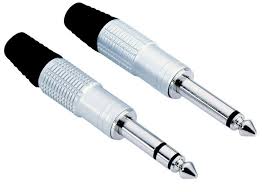 Dating from the 1800s, this connector is one of the best know audio plugs. Applications are: high impedance microphones, headphones, line level interconnections, speaker level, guitar pickups, and patch bays. First user was the telephone industry. Available in 3 conductor, Tip-Ring-Sleeve (TRS, Balanced, Stereo) and 2 conductor, Tip-Sleeve (TS, Unbalanced, Mono). Similar connector also available in ⅛”.
Dating from the 1800s, this connector is one of the best know audio plugs. Applications are: high impedance microphones, headphones, line level interconnections, speaker level, guitar pickups, and patch bays. First user was the telephone industry. Available in 3 conductor, Tip-Ring-Sleeve (TRS, Balanced, Stereo) and 2 conductor, Tip-Sleeve (TS, Unbalanced, Mono). Similar connector also available in ⅛”.70-Volt System
When speakers are distance from the amplifier or many speakers are to be powered by one amplifier, a 70-volt system is recommended. It is a high impedance distribution system in which each speaker has a step-down transformer which can be tapped to get different amounts of power form the distributed system. The amplifier usually has a step-up transformer at it’s output. Having a high impedance distribution system allows smaller gauge wire to be used and many speakers to be connected to a single power amplifier. Most background and paging systems are 70-volt.
Amplifier
An electronic device that increases the voltage, current, or power of a signal, by taking energy from a power supply and controlling the output to match the input signal shape, but with larger amplitude.
AES/EBU
The “Audio Engineering Society” and the “European Broadcasting Union” professional protocol that conveys two channels of interleaved digital audio data through two-conductor cable.
Autoformer
Baffle
Any box like inclosure or surface used to mount a loudspeaker, and which acts as sound absorbers to prevent sound waves from radiating through a designed space.
Balanced Audio
This is a method of interconnecting audio equipment using balanced lines. This type of connection allows the use of long cable runs while reducing susceptibility to external noise and RFI (Radio Frequency Interference). Balanced lines use three-conductor connectors, usually XLR or 1/4 TRS Phone. This allows the use of two audio signals with one 180 degrees out of phase, to cancel out unwanted noise.
Banana Plug
Bandpass Filters
An electronic circuit or device that passes frequencies within the middle range and attenuates frequencies outside the range
Bandwidth
The range of audio frequencies of a system. The higher the audio bandwidth, the better the sound quality. Expressed in hertz (Hz) or musical octaves.
Bluetooth
A protocol for the short-range wireless interconnection technology and data exchange between electronic devices.
Boundary Microphone
Bus
A set of electrical conductors common to three or more circuits, which transmit data, audio signals, or power with in a system.
Capsule
The inner element of a microphone that changes sound into a small electrical current.
Cardioid
Unidirectional microphone which picks up sound coming from one direction more than another, usually from the front. As sound approaches from the angles more to the rear, sound pickup is diminished; commonly used a vocal or speech microphones.
Coaxial Speakers
Compressor
Condenser Microphone
Type of microphone in which a capacitor (condenser) is formed by placing a thin diaphragm in front of a metal disk and applying voltage externally to create sound. Condenser microphones generally produce a high-quality audio signal and are a popular choice for recording studios.
Crossover
Daisy Chain
Connecting several devices together in sequence.
Damping
Reducing or controlling unwanted motion in the cone or diaphragm of a driver after the signal disappears; the motion can often cause undesired noise or ringing.
DAW
The “Digital Audio Workstation” is a computer software system for recording, editing, and producing audio files.
Diaphragm
The part of the microphone or speaker that moves and converts sound energy to electrical energy, or vice versa. It usually has the shape of a cone or dome and is constructed of a thin membrane.
Diffraction
When sound waves change direction or are deflected from their normal path as a result of an encounter with a physical obstacle.
Distortion
An undesirable change of the original shape of a sound or waveform which will result in an abnormality.
Driver
Equalizer
An electronic set of filters designed to modify frequency balance of an audio source.
Exciter
An audio signal processing effect that synthesizes high frequency harmonics.
Expander
A device that increases the dynamic range of a signal by decreasing the amount of low-level signals and increasing the amount of high-level signals.
Feedback
Sound distortion produced by the returning of part of the output signal from a device to the input of the same device. An in-phase audio loop.
Flanger
A device that alters a sound by playing two copies of the same signal at the same time, with one significantly slower than the other, and then recombining them.
Frequency
The number of times a wave repeats per second. Frequency is measured in hertz (Hz). For sound, frequency determines pitch.
Frequency Band or Range
The sections of frequency between points at the upper and lower ends of the spectrum of radio communication frequencies. Channels are usually grouped or designated for the same purpose under a frequency.
Gain
Related to audio, gain represents the amount of amplification of an audio signal; the increase level of audio or the volume of audio. Gain is usually expressed in unites of decibels (dB)
Ground Lift
Can eliminate unwanted hum and buzz by disconnecting the cable shield connection between the signal ground and the chassis ground.
Hypercardioid
Unidirectional microphone with a slightly larger rear pickup than the supercardioid microphone, and significantly more rear pickup that a cardioid microphone.
Hi-Pass Filter
Horn
Impedance
An expression of the resistance and reaction of an electronic component in an alternating-cuttent (AC) circuits; measured in ohms.
Lavaliere Microphone
Limiter
A device designed to leave the dynamic range of the signal unmodified until it reaches a certain threshold above which the signal is compressed at a high ratio (16:1 or greater) so it does not get louder.
Line Level
This is the specified strength of an audio signal used to transmit analog sound between audio components such as CD and DVD players, mixing consoled and equipment. Consumer audio is at -10 dBV, while pro-audio is at +4 to +10 dBu.
Lo-Pass Filter
Mic Level
This is the signal strength of the output of a microphone, -40dBV.
Mixer
A device for combining or multiplying signal inputs together into a common output.
Noise Gate
An electronic device or software that regulates the volume of an audio signal. Noise gates attenuate signals registering below the cutoff decibel, by a fixed ratio.
Off-Access Coloration
The change of tone quality for audio sources received received off-center (off-access) to the microphone.
Omni-Directional Microphone
A microphone that picks up sound equally in all directions, no matter which way the microphone is pointed.
Pan Control
A control found on mixers used to position a signal sound channel somewhere between the left, center, or right loudspeakers.
Parametric Equalizer
Phantom Power (48V)
The transmission of DC electric power through cables to remotely operate microphones that contain active circuitry (condenser microphones).
Phaser
A filtering effect created by variable phase shift of an audio signal mixed with the direct signal. Combining the two signals results in a moving comb-filter effect which sounds like a series of peaks and troughs in the frequency spectrum.
Phoenix Connector
Pink Noise
Random noise that has equal energy in all octaves, therefore having more low-frequency components than white noise. Pink noise is used for measuring the frequency response of speakers and rooms.
Polar Pattern
A plot of microphone’s pickup sensitivity to sound coming from different directions with varying degrees.
Potentiometer
A three terminal resistor that changes the potential over an electronic circuit. In audio, potentiometers (or pots) are often used as a rotary or slide volume control for a device.
Preamplifier
An electronic device that prepares a small low-level electrical signal and passes it on to a power-amplifier for more amplification or processing.
Processor
A device that modifies audio signals by changing their dynamics or frequency content to accurately reproduce the characteristics of a sound. Examples include equalizers, compressors, and gates.
RCA Connector
Shotgun Microphone
Speakon
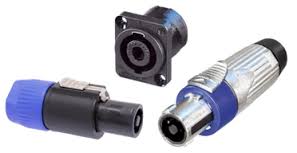 This type of connector, manufactured by Neutrik, is used on the output of amplifiers and the input of speakers. Available in 2, 4, or 8 pin configuration it is an improved mechanical connection over the 1/4 TS because of the physical connection, locking ability, and self cleaning contacts. Used only in speaker level applications.
This type of connector, manufactured by Neutrik, is used on the output of amplifiers and the input of speakers. Available in 2, 4, or 8 pin configuration it is an improved mechanical connection over the 1/4 TS because of the physical connection, locking ability, and self cleaning contacts. Used only in speaker level applications.Supercardioid
Unidirectional microphone with more front pickup and less rear pickup.
Sub-Woofer
A large “woofer”, or loudspeaker, exclusively used for low-pitched audio frequency reproduction (20-100Hz).
Transducer
In audio, a sensor that converts sounds into electrical energy (signal) or vice versa. Examples are microphones and speakers.
Transformer
Unbalanced Audio
This protocol is used in audio equipment using unbalanced lines. This type of connection is used on short runs, interconnecting rack equipment. Not recommended for long cable runs due to it’s susceptibility to unwanted noise and interference. Unbalanced lines use two-conductor connectors, usually 1/4 TS Phone or RCA Phono. There is no audio quality difference between balanced and unbalance signals.
Woofer

